Our articles are not designed to replace medical advice. If you have an injury we recommend seeing a qualified health professional. To book an appointment with Tom Goom (AKA ‘The Running Physio’) visit our clinic page. We offer both in-person assessments and online consultations.
I arrived in our clinic and there, sat on the desk was a box with “Air Mail” written on it. Airmail? I never get Air Mail and yet here it was, looking fresh despite a long journey from Canada. I was like a child in a sweet shop. A very geeky child in a sweet shop that sells high-tech rehab equipment!
As soon as I’d torn off the tape and opened the box I knew we had a product on our hands. The first thing that greets you is the black AFX carry bag, neatly folded on top. Peel that away and the first sight is a little intimidating – the footpad, the cables, the handles and pole – and yet I was pleasantly surprised to find it came ready to use, literally straight out of the box. It comes with foolproof instructions and a 30 minute instructional DVD.
In seconds the socks were off and AFX was on. It feels really comfortable on the foot, almost like it gives it a little hug. You can instantly feel the muscles around the foot and ankle working as you use it. But “feel” isn’t enough for me. I wanted something a bit more objective, so I put it through its paces with a 3 stage review process…
Stage 1 – EMG Tests
EMG (Electromyography) is an assessment used to determine the electrical activity within a muscle. It is a measure of how well a muscle is activating. In this case the higher the value the better. We used our EMG unit to assess how red, medium level AFX compared with black resistance band ( XX Heavy resistance from Stretchaband) Tables below detail the approximate resistance profiles of each. There are a lot of variables in this assessment and it was only done on 1 subject (me!) so it’s an approximation rather than firm scientific research.
Stretchaband is a latex-free resistance band, ranging in strength from yellow to black. Further details can be found here.
Black was chosen as its resistance at 100% elongation (double normal length) was similar to the red level on AFX. These can only be approximated as resistance varies hugely depending on elongation, as the chart shows.
For this stage we assessed the maximal EMG score achieved when testing a) gastrocnemius (calf) muscle contraction and b) Tibialis Anterior contraction. The best score of 5 attempts was recorded with maximal stretch on the resistance band or AFX.
The picture on the right shows EMG set up to test Tibialis Anterior.
Stage 2 – Fatigue test
We compared numbers of repetitions needed to fatigue the calf muscle using the black band and red AFX with maximal stretch.
Stage 3 – Group Evaluation
I work with a lovely team of experienced physios and they kindly gave up an hour of their time to try out the AFX, compare it to resistance band and discuss their findings. They had 2 main questions to answer;
- Does AFX have key advantages to resistance band?
- Are there disadvantages to AFX?
The results
Stage 1
AFX scored higher than resistance band for both gastrocnemius and tibialis anterior muscles in our EMG studies;
For the gastrocnemius muscle, both AFX and resistance band scored less than a single leg calf raise. This isn’t surprising as this involves resistance of the entire body weight. That said, AFX scored 425 to single calf raise at 460. Had we used a harder AFX level we may well have achieved the same muscle activation.
Stage 2
Guest blogger and fellow Physio Andy took on this challenge (as he has calf muscles of solid steel!). He did AFX first and his calf muscle fatigued at 36 reps. He repeated the test with a resistance band after a rest period…he stopped at 70 reps and still hadn’t fatigued the calf.
Stage 3
At first, I think our team were a little sceptical and I faced the question, “isn’t it just a posh resistance band?” Their views soon changed once they’d had a chance to use the AFX. After some experimenting, they answered the questions
- AFX does have key advantages to a resistance band. It provides a harder resistance, appears to increase activity in the intrinsic muscles in the foot and proved an easier way of resisting foot and ankle movements. It also can be used for stretching and improving ankle range of movement, I found it especially useful for improving ankle inversion (turning in) which can be a challenging movement to stretch. Because AFX attaches to the toes and metatarsals it allows you to combine movements such as plantar flexion and toe flexion to work multiple areas. The way AFX attaches also prevents slippage that you can get with a resistance band and maintains resistance throughout. Because of this, it was easier to use than band for eccentric muscle work, especially on Tibialis Posterior.
- The only noted disadvantages were cost and portability. It was pointed out that resistance band could fit in a handbag or travel bag when AFX probably couldn’t.
AFX in action;
[youtube https://www.youtube.com/watch?v=2HwLmSNcM4Q&w=853&h=505]
Conclusion
Overall AFX is an exciting new product that has multiple uses and our testing indicates it’s a more effective way of strengthening the foot and ankle. The AFX certainly “feels” like it works the muscle harder and the EMG results suggest it achieves better muscle contraction than resistance band. Not only this, but it fatigues muscles more efficiently – with resistance band it took double the reps needed with AFX to reach fatigue. Our usual rep range to improve endurance is 15-25 reps. Fatigue was achieved at 36 with the AFX, with 2 harder levels of resistance available it is likely we could work in this range using a harder level. Resistance band needed over 70 reps to reach fatigue with the hardest band available to us, at a maximal stretch. It’s unlikely this would improve strength or endurance and this is consistent with what I’ve found with patients – resistance band doesn’t offer enough resistance to improve most people’s calf muscle strength. It is probably adequate for the smaller muscles involved in inversion and eversion but for calf rehab, I would definitely choose AFX over resistance band.
This review isn’t just about AFX vs band. AFX stands on its own as a product. In many areas in rehab, we have several tools that aim to achieve a similar goal, each with its own benefits. Take wobble boards, rocker boards, balance cushions, BOSU balls etc etc. they all work balance in slightly different ways. Resistance band certainly has a role and this review shows that AFX does too. The only downside is cost. Bought in bulk, bands can be as little as £1 to £2 per metre. Currently, AFX is not available in the UK but manufacturers are hoping to introduce it in Autumn/ Winter. In Canada and the US it is available in 2 different packages, standard at $99 and “Pro” at $129.
To put this into perspective though, a BOSU ball in the US cost $109 (at BOSU.com) and my running shoes (Gel Kayano 18) around $140. For individuals, it may be at the top end of their budget but for a product that could really help rehab foot and ankle problems, which are very common in runners, it could be money well spent. As it’s easy to clean, physiotherapy clinics could invest in an AFX and potentially use it for multiple clients.
Final thoughts: AFX is an exciting and innovative new product in foot and ankle rehab. It shows great potential for strengthening and stretching and has clear advantages over resistance band if you’re happy to pay the extra cost.
For more information on this product check out their website or chat to Matt on @afxonline on Twitter.
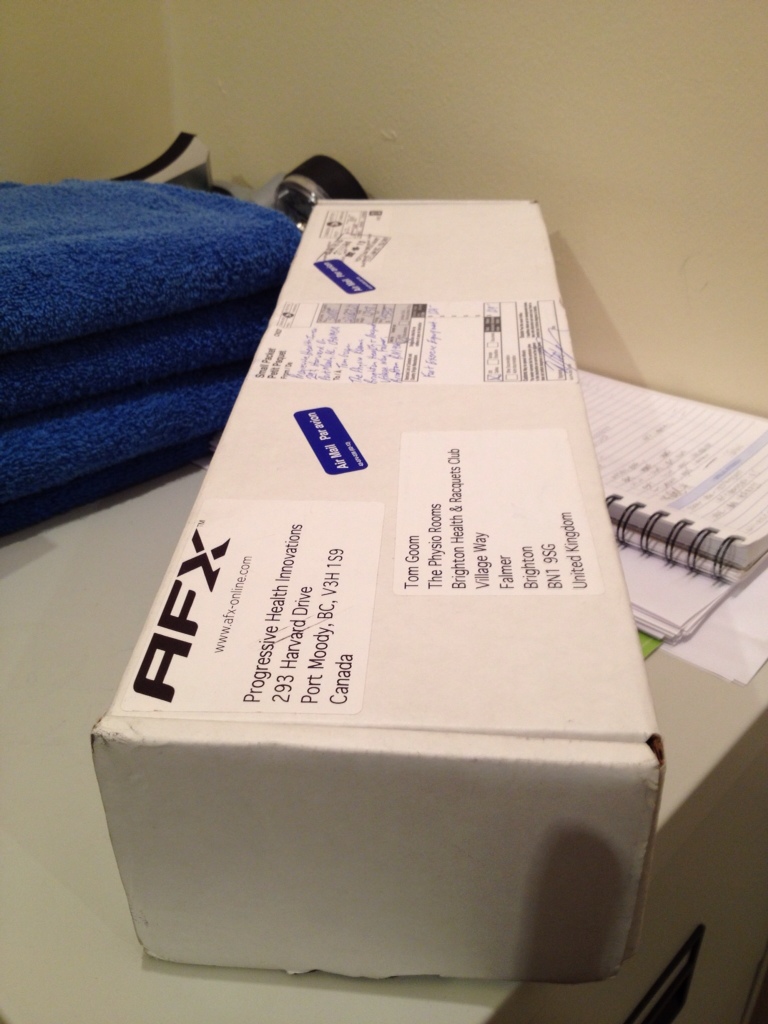
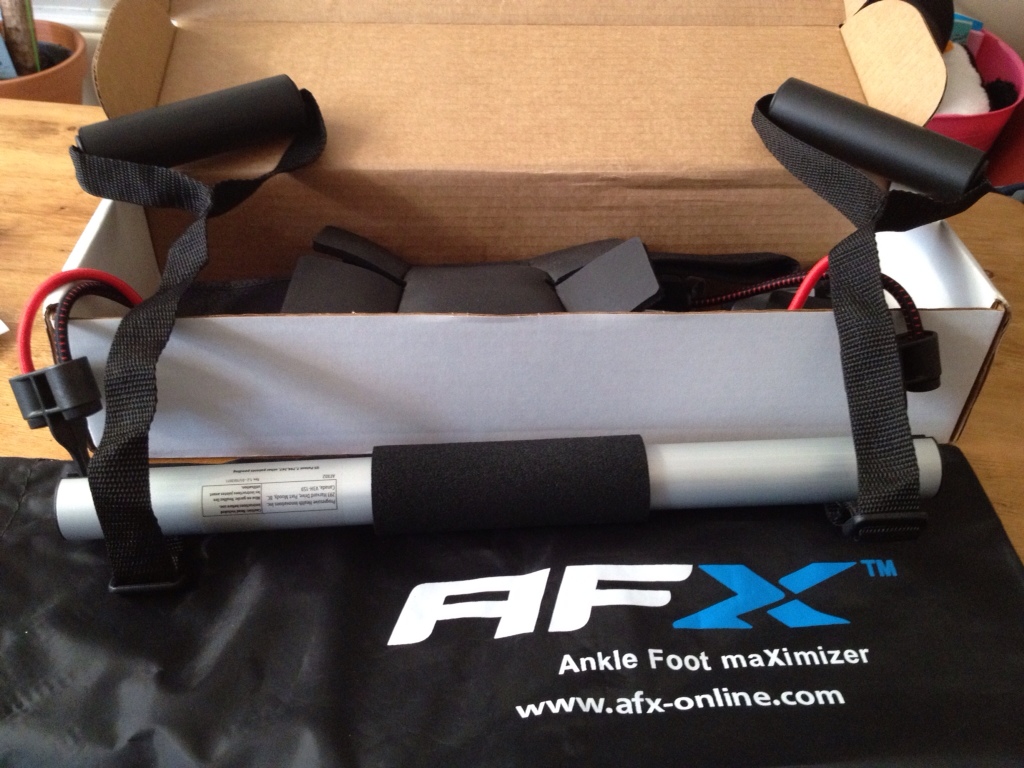


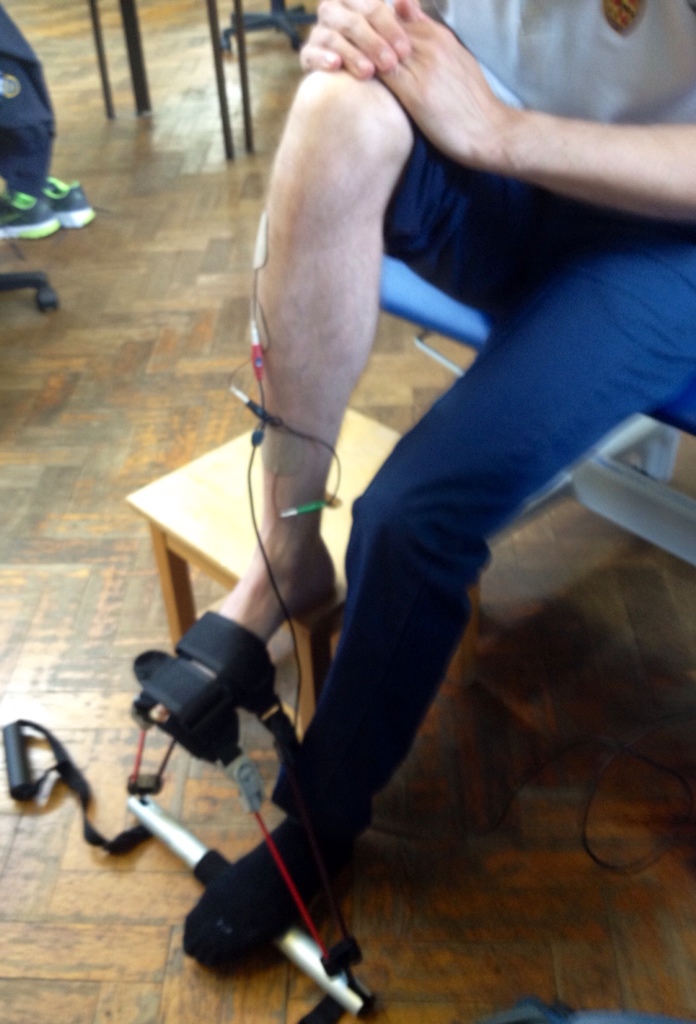

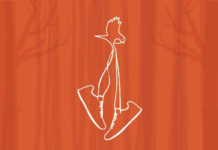

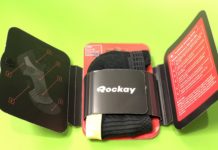







Wow, great review and it sounds like a good piece of kit…shame about the price though….Crickey, £100? I suppose it is an investment, especially if you get recurrent injuries and need to constantly carry out a maintenance rehab programme.
Hi Tom – thanks very much for reviewing AFX, when you said that you were excited to ‘test it out’, I had no idea that you’d be using the machines that go ‘ping’. 🙂 But glad you did.
In regards to price, every company wants to make a product as low-cost as possible (sell more) however, we had to ensure that we made a product that was durable and wouldn’t break easily. AFX is built to withstand up to 200kgs, while also being flexible and comfortable on the foot (loved the ‘hug’ analogy, btw). Therefore we used military-grade bungee, an aluminum mid-bar, climbing straps for the handles, the connection pieces are made of glass-filled nylon (vs, plastic), and the foot support uses this incredible fabric called ‘hypalon’. George, you are correct in that it is a bit of an investment, but we believe it is a good one.
We are looking forward to making it available in the UK, if any readers have suggestions for top-notch retailers that we should contact, kindly let us know.
Cheers,
Matt
Hi Matt,
You can’t beat machines that go ‘ping!’
Nice picture, is that you on “Daddy Duty”?
Tom
Yes, that is me with my oldest, Liam. We were at a stadium for a charity event, completely unprepared for a water park (no bathing suits / towels / change of clothes), but when we walked by he got so excited – so, off we went!
Just found 2 other uses for AFX
1) it’s great for hamstring stretching
2) it’s quite a powerful catapult!
LOL. Just an FYI, we don’t have regulatory approval for catapulting.
I like it mate, I take it back that it’s a posh resistance band…. Good review, calf is a bit of a given, if you want to exercise it, do a calf raise, better for the all round motor units, proprioceptive response etc etc. Very good though for initial calf rehab, as obviously you can limit/change the resistance.
What is really like to see (in a stage 2 of review lol) is it’s effect on tib post rehab, as we all know is difficult to rehab, or get the maximal effect with rehab. The AFX looks like it would beat a band hands down tbh. Again, here less the functional argument but looks like a great product for early phase rehab. And as usual tom, great blog!
Thanks Stu,
I’m making a video on AFX for PTTD actually. It’ll go on the original PTTD post when it’s ready.
You’re right about calf raises. I think AFX could neatly fill that gap for people stuck between being able to calf raise on both legs, to managing on just one. Excellent for calf tears or Achilles rupture. They struggle a lot to achieve single leg calf raise and yet band work isn’t challenging enough.
How’s your meniscus article coming on?
AFX is only available in Canada & US? 🙁 But I really REALLY need one. I hate silly Stretchaband, it always rolls down my foot or flies off my toes.
Hi Emma,
I’m sorry but it’s not available just yet. If you follow @axfonline on Twitter he’ll keep you updated with when it’s likely to arrive in the UK. Do you have problems with your ankles?
Tom
Hi Tom. I have really weak feet and ankles which has lead to a bunch of problems like ankle sprains, Achilles tendonitis, and now I am getting pain at the bottom of my foot and I worry that it is planter fasciitis. I have been trying to do exercises to get them stronger but am so frustrated!
Sounds frustrating, are you seeing a Physio?
Are you doing balance work too? Using a rocker board or BOSU?
I am sorry Emma, we can’t yet sell AFX in the UK because it is classified as a medical device and therefore, we have to get regulatory approval and also have a representative in the UK. The *moment* that happens I’ll let Tom know, but please also email us at ‘[email protected]’ and just ask to be put on our UK waiting list.
Thank you Tom. I am doing balance work, using a Bosu (both sides), and have seen some improvement, but my physio says that the weakness really starts in my feet and toes, and that’s why I’ve been using stretchaband. Watching the videos on the AFX website, it looks like it really strengthens the feet.
Sounds like you’re doing the right rehab, how long have you been doing it?
It might help to also look at the balance around the knee, hip and trunk. Training glutes and “eccentric” quads control often helps balance a lot, which, in turn would help your ankle and foot.
Have a look at the balance and control post on this site, and the glutes rehab one. I’d be tempted to add the single leg dip exercise to what you’re doing (if you aren’t doing it already). It’s detailed in a video in our balance article.
http://runningphysio.wordpress.com/2012/05/28/movement-control-and-balance/
http://runningphysio.wordpress.com/2012/05/08/gluteus-medius-strengthening/
afxmatt, I just saw your reply, are you sure that I can’t just buy one and you mistakenly send it to the UK? 😀
LOL Emma. No, unfortunately, I can’t. Please send an email and I promise you’ll be at the top of the list.
Thank you Tom. I have been having trouble with my feet and ankles for 3 years now, it is terribly discouraging. I have been doing some knee and hip exercises, but I’ll definitely look at your videos.
Thanks afxmatt, can’t blame a girl for asking, can you? 😉 I have family in Canada, what if I had it shipped there and they sent it to me?
Nice chatting to you Emma, I hope it all works out. If you’re based near Brighton and would like a second opinion then let me know, I could see you in my clinic. Right now though I’m off to bed, have a patient at 8am tomorrow and need my beauty sleep!
Tom makes some great suggestions. Often foot and ankle issues can be linked to issues in the knees, hips and core. Strengthening the foot and ankle will help, but if your leg / hip / core remain weak or dysfunctional, that will work against any gains that you make.
Buying in Canada and having family ship it to the UK? You are cheeky! LOL. I can not respond to that question. 🙂
[…] an innovative alternative to resistance band and we have full details in our RunningPhysio review here. Here is how you’d use it for […]
[…] an innovative alternative to resistance band and we have full details in our RunningPhysio review here. Here is how you'd use it for […]
That ankle foot looks really good for ankle injuries. I am wonder whats the material of the bar and how long it is , I can imagine about 18”? . Im planning to gift it to one friend in Europe and I doubt it could be packed.
Thanks for all.
Great work !
Hi Sammy – the midbar is made of aluminum and is 16 inches (~41 centimenters) long. I’ve traveled extensively with AFX’s in my luggage (both checked & carry-on baggage) and have never had a problem with airport security. In regards to Europe, we currently can only ship to the US & Canada.
Thanks!
Comments are closed.